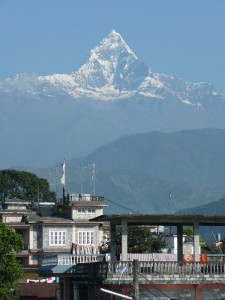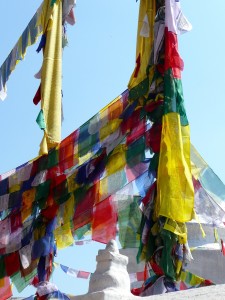
Looking northwest from Pokhara to Mt. Machapuchare in the Annapurna Himals. Nangi lies on the other side of this mountain locally known as “Fishtail”.
When Mahabir Pun was 14 years old his father, Kisna, moved him to the Terai region of Nepal so Mahabir could attend the 9th and 10th grades. The year was 1969. It was out of the question to have sent him to a boarding school in Pokhara due to costs. Kisna would have to pay a monthly fee for the 9th and 10th grades because the Nepal government only supported education until the 5th grade. It was all he could afford. Pokhara would have been closer and allowed Kisna to continue farming his Nangi lands, but there were no relatives in Pokhara at that time and he would depend on his Terai relatives for housing and work. This is why only Kisna and Mahabir went; the rest of the family followed two years later. It was a huge sacrifice to leave his family lands and start anew…to leave his family once again must have been a difficult decision. It is also a tribute to the strength of his mother, Purbi.
The Terai is the southern most part of Nepal; the plains are as flat as the mountains Mahabir grew up in are high. This land was once a great forest but lumber was harvested in the 1800s for the railroad industry. During the 1960s malaria was eradicated using DDT and the area became the equivalent of the American frontier back in the 1800s. Even now it is reported as the most productive region of Nepal with agriculture as the backbone supporting industries such as tobacco factories and rice mills. During the 1960s farmers from the mid-hill regions came in search of better land for their animal stock and crops. They found the flat plains more fertile and easier to farm then the narrow terraced fields of the mid-hills.

Buddhist prayer flags. West of the Chitwan area is the birthplace of Buddha in Lumbini, twenty-five hundred years ago.
Mahabir recalls walking from Nangi to the Terai region with his father. I know it takes two days to walk from just Nangi to Pokhara and six hours by bus from Pokhara to the Terai. He said they walked for days, but according to Nepali custom they had only to knock on a door and ask a stranger for shelter and a meal along the way. Arriving in the Chitwan area, which is the central Terai, they lived with relatives. Mahabir attended school and helped his father farm. He told me there were trained teachers, not just local volunteers, who taught in the schools and he used textbooks for the first time. Two years later at age sixteen he completed his studies only to be packed off to Kathmandu and what was then called college by a father who would not pause his quest to educate his children.
Do you have a memory of moving and/or changing schools to tell your fellow readers? Share your stories and comments by clicking on the comment bubble in the upper right hand corner of this blog entry. I can still recall sitting in my first college class at age 29. 18-year-old students who were debating the best way to get drunk surrounded me. I knew the best way to get spit-up stains out of a blouse but I didn’t think they would be interested….or maybe they would be after a night of drinking. Join me next week and read about Mahabir Pun’s high school days in Kathmandu.
